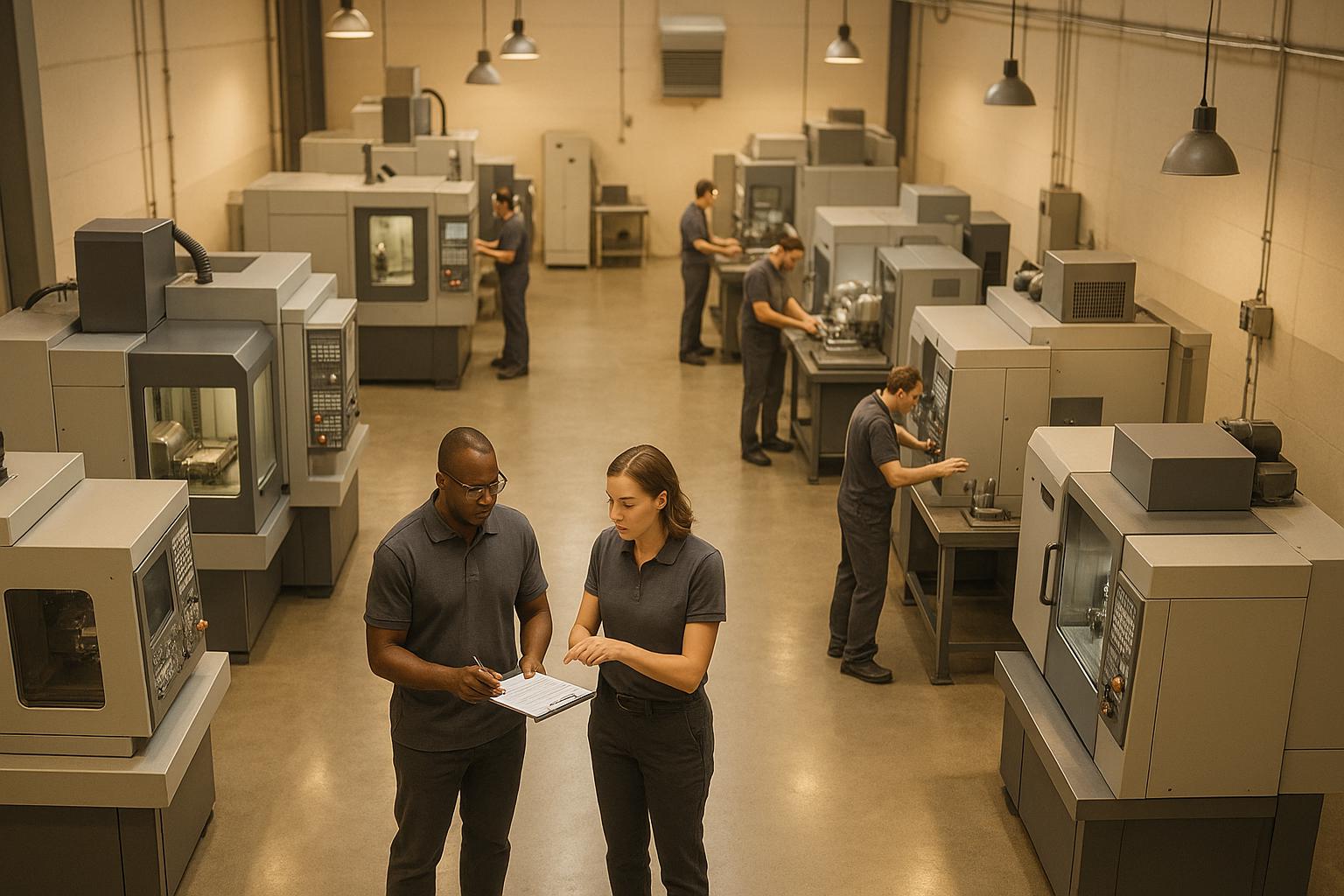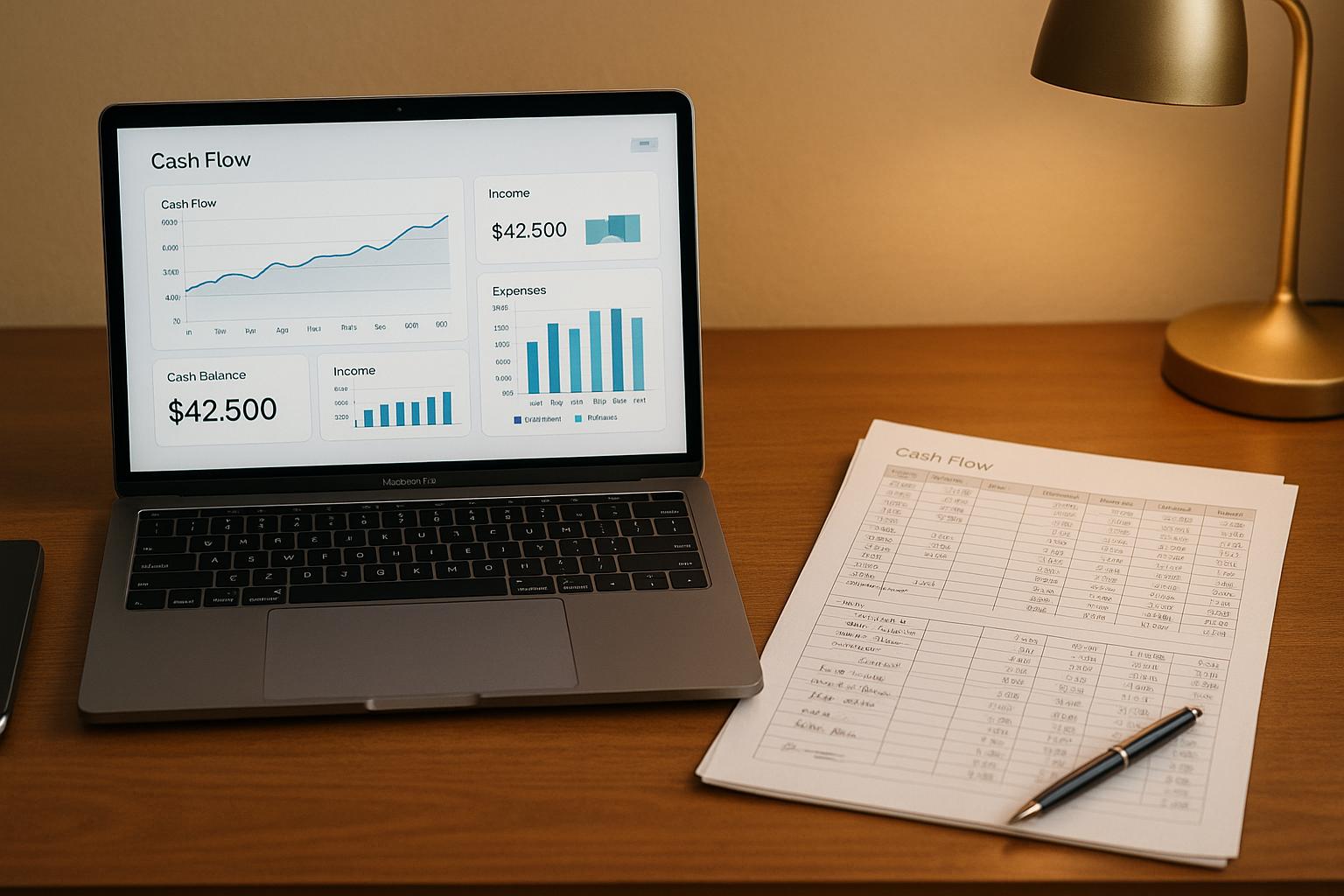How to Optimize Energy Use in Manufacturing

Want to save on energy costs in manufacturing? Start by identifying waste, upgrading equipment, and streamlining processes. Here’s a quick guide to boost efficiency:
- Conduct an Energy Audit: Review utility bills, inspect equipment, and map energy flows to find waste.
- Use Monitoring Tools: Install power meters, infrared cameras, and energy management software for real-time insights.
- Set Up an EMS: Automate controls, balance power loads, and predict energy needs with an Energy Management System.
- Upgrade Equipment: Replace motors, compressors, and lighting with energy-efficient models.
- Optimize Production: Schedule tasks smartly, reduce downtime, and maintain equipment regularly.
These steps cut costs, reduce waste, and improve operations. Dive into the article for more details and actionable strategies.
How to Complete an Energy Audit
An energy audit helps you identify energy usage, waste, and potential savings. It involves a detailed evaluation of all energy-consuming systems and equipment in your facility.
Energy Audit Checklist
To get started, gather and analyze data on energy consumption. Key steps include:
- Utility Bills Analysis: Review 12 to 36 months of utility bills to understand baseline consumption and identify seasonal trends.
- Equipment Inventory: Record details like equipment age, specifications, and operating hours.
- Production Schedule Review: Compare energy usage during peak production times and downtime.
- Building Systems Assessment: Inspect HVAC systems, lighting, compressed air systems, and the building envelope.
- Process Equipment Review: Check manufacturing equipment for efficiency and review maintenance records.
- Energy Flow Mapping: Track energy flows to identify waste and prioritize improvements.
Energy Monitoring Equipment and Software
Once energy flows are mapped, use monitoring tools to track key metrics and gain deeper insights.
| Equipment Type | Purpose | Key Measurements |
|---|---|---|
| Power Meters | Track electrical consumption | kW, kWh, power factor |
| Infrared Cameras | Detect heat loss | Temperature variations |
| Data Loggers | Monitor usage patterns | Usage trends, peak demand |
| Air Flow Meters | Assess compressed air systems | CFM, pressure drops |
| Power Quality Analyzers | Monitor electrical systems | Harmonics, voltage issues |
Modern energy management software can enhance monitoring by consolidating data into one platform. Features to look for include:
- Real-time Dashboards: Visualize current energy usage at a glance.
- Automated Reports: Summarize consumption patterns regularly.
- Alert Systems: Notify you of unusual energy spikes.
- Benchmarking Tools: Compare performance against industry standards.
When choosing monitoring tools, check for compatibility and scalability to ensure they meet your facility's needs. The right setup will help you uncover insights that lead to better energy efficiency across operations.
Setting Up Energy Management Systems
Using insights from energy audits, implementing an Energy Management System (EMS) turns raw data into practical energy control measures.
EMS platforms streamline the monitoring and management of energy use in manufacturing settings. They integrate with your existing equipment to provide real-time data and automate adjustments to improve efficiency.
Core Functions of Energy Management Systems
An EMS includes several features designed to manage energy use effectively:
| Function | Purpose | Key Benefits |
|---|---|---|
| Real-time Monitoring | Tracks energy usage across equipment and processes | Quickly spots unusual consumption patterns |
| Automated Controls | Adjusts equipment settings based on production needs | Cuts energy waste from idle equipment |
| Load Management | Balances power distribution across the facility | Avoids costly demand charges during peak usage |
| Predictive Analytics | Uses historical data to forecast energy needs | Enhances production planning and cost control |
| Integration Capabilities | Links with existing systems and equipment | Provides a complete view of energy usage |
System Setup and Staff Training
-
Assessment Phase
Begin by evaluating your current systems. Document all energy-consuming equipment and identify control requirements. -
Hardware Installation
Place sensors, meters, and control devices in key areas, such as production equipment, HVAC systems, lighting, motors, and compressed air systems. -
Software Configuration
Configure the system by setting up equipment profiles, defining operational parameters, establishing alert thresholds, creating reporting templates, and assigning user access levels. -
Staff Training
Provide focused training that includes:- Navigating the system and interpreting data
- Responding to alerts and troubleshooting problems
- Routine maintenance and generating reports
sbb-itb-e766981
Upgrading to Energy-Saving Equipment
Switching to more efficient equipment can cut energy use and reduce costs. Modern manufacturing tools can improve energy efficiency by 20–40%, making them a smart investment.
Key Equipment to Upgrade
Focus on equipment that uses the most energy in manufacturing. Here's a breakdown:
| Equipment Type | Average Energy Usage | Savings with Upgrades |
|---|---|---|
| Motors and Drives | 65-70% of industrial electricity | 30-50% with variable frequency drives |
| Compressed Air Systems | 10-15% of facility power | 20-35% with modern compressors |
| HVAC Equipment | 10-20% of total energy | 25-40% with smart systems |
| Lighting Systems | 5-10% of facility usage | 50-75% with LED technology |
| Process Heating | 15-25% of energy costs | 15-30% with heat recovery systems |
For the best results, focus on upgrades that match your facility's energy demands. Some examples include:
- Motors: Opt for NEMA Premium® models for better efficiency.
- Compressors: Choose systems with automatic pressure adjustments.
- Heat Recovery: Install equipment to reuse waste heat.
- LED Lighting: Replace older fixtures with smart LED systems.
After identifying upgrades, evaluate their financial impact.
Analyzing Costs and Benefits
To make informed decisions, calculate the return on investment (ROI) for each upgrade. Here's what to consider:
1. Upfront Costs
- Factor in the purchase price and installation expenses.
- Don't forget costs for disposal or temporary production disruptions.
2. Annual Savings
- Calculate energy savings: Current annual energy cost - Projected annual energy cost = Annual savings.
- Include reduced maintenance and improved productivity.
3. Incentives
- Look into local utility rebates, tax credits, and government programs for equipment upgrades.
4. Payback Period
- Use this formula:
Payback Period = (Investment - Incentives) ÷ Annual Savings
For example, replacing a 100-horsepower motor might look like this:
- Investment: $12,500
- Utility rebate: $2,500
- Annual energy savings: $4,000
- Payback period: ($12,500 - $2,500) ÷ $4,000 = 2.5 years
Upgrades with payback periods under three years typically offer the best returns. Also, consider the lifespan and maintenance needs of the equipment before making your final choice.
Reducing Energy Waste in Production
Improving production processes can cut down energy waste significantly. Smart planning and managing equipment efficiently are key steps toward achieving noticeable energy savings.
Energy-Saving Production Methods
Production scheduling has a big impact on energy efficiency. Grouping similar tasks can reduce the need for frequent equipment warm-ups and cool-downs.
-
Load Leveling
Spread out production schedules to avoid energy demand spikes. Start high-power equipment at staggered times and distribute energy-heavy processes more evenly. -
Process Integration
Combine operations to use less energy:- Run product lines with similar temperature needs at the same time.
- Schedule high-temperature processes back-to-back.
- Coordinate equipment usage to make the most of overall capacity.
-
Material Flow Optimization
Streamline material handling to lower energy use:- Work closely with suppliers for just-in-time production.
- Adjust facility layouts for smoother, more efficient workflows.
These strategies work well alongside real-time monitoring and automated systems, helping minimize energy waste during downtime.
Managing Equipment Downtime
Once production processes are optimized, managing idle equipment becomes the next step in boosting energy efficiency. Equipment left running unnecessarily still consumes a lot of power.
-
Automated Shutdown Protocols
Use tailored shutdown procedures based on how long equipment will be inactive:Duration Action Energy Savings Description Short Breaks (15–30 min) Set equipment to standby mode for quick restarts Provides moderate savings Meal Breaks (30–60 min) Fully shut down non-critical systems Delivers noticeable reductions Overnight (8+ hours) Power down the entire facility Results in substantial energy savings -
Smart Idling Systems
Energy management systems can automatically adjust equipment power states based on production needs:- Activate sleep mode after a set idle period.
- Enable quick restarts for critical machines.
- Monitor power usage to spot unnecessary runtime.
- Use sequential startups to manage power loads effectively.
Preventive maintenance also plays a big role in keeping machinery efficient. Well-maintained equipment uses less energy than neglected systems. Key areas to focus on include fixing leaks and optimizing pressure in compressed air systems, using setback temperatures for heating, installing motion sensors for conveyors, and applying temperature-based controls for cooling systems.
Conclusion: Steps to Improve Energy Efficiency
Improving energy efficiency starts with action and planning. Begin by conducting an audit to identify how much energy you're using and where it's being wasted. Use modern monitoring tools to spot inefficiencies.
Based on the audit results, focus on upgrading outdated equipment, such as compressed air systems, industrial motors, or heating and cooling units. When making purchases, consider the total cost over time, not just the upfront price.
Plan smarter by grouping temperature-sensitive tasks and staggering the startup of high-power equipment. This helps avoid sudden spikes in energy demand and keeps costs down.
Train your team to shut down equipment during breaks and downtime. Routine maintenance is also key - fix air leaks, improve insulation, and ensure motors are running efficiently.
Make energy management a regular part of operations. Assign a team to track usage, suggest improvements, and review metrics to ensure progress.
Energy efficiency isn’t a one-time effort. Start with the biggest issues identified in your audit and tackle additional areas over time. This builds momentum and ensures lasting improvements in energy use.




